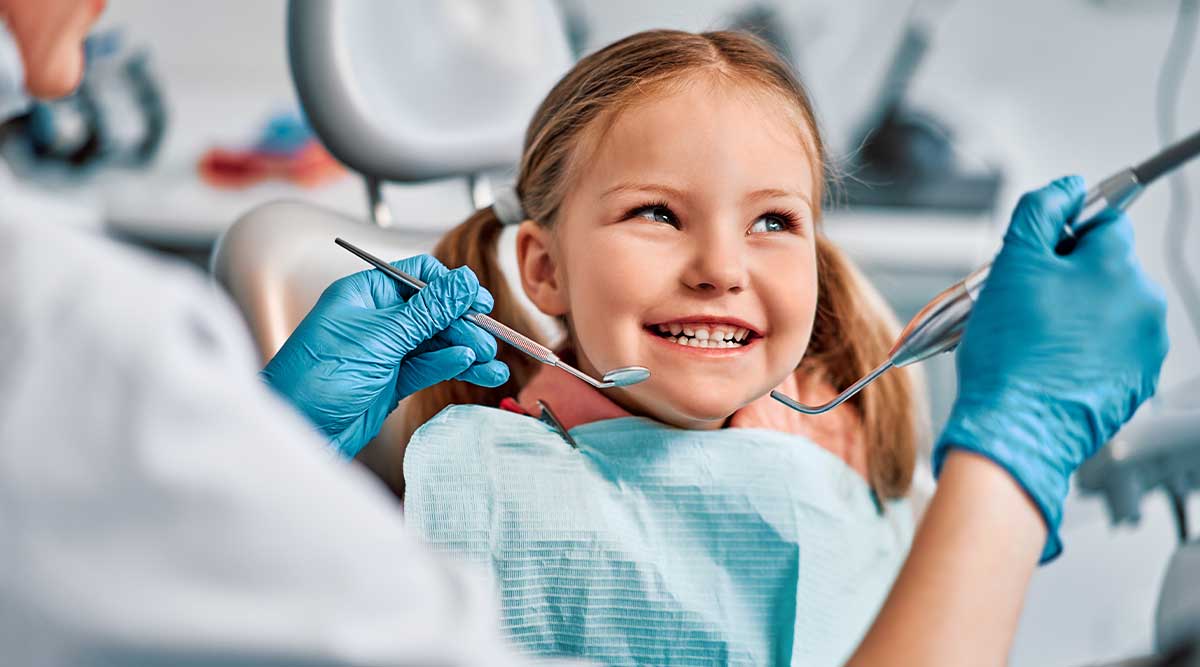What is Pediatric Dentistry (Pedodontics)?
The department of pediatric dentistry is called Pedodontics. Pedodontists are also called pediatric dentists. Pedodontics treatments aim to protect the milk and permanent teeth of babies and children aged 0-16, and to eliminate dental disorders caused by caries, trauma, hereditary factors, etc.
Pedodontics focuses on children’s dental development, oral health, dental diseases, and treatment methods.
Pediatric Dental Treatments | What are Pediatric Dentistry (Pedodontics) Treatments?
Some common types of treatment in pediatric dentistry (Pedodontics), in other words, pediatric dental treatments, aimed at protecting children’s dental health:
- Dental Examination
The first examination is very important in children’s dental treatments.
The first dental examination in children should be at 6 months, when the first milk tooth erupts. This is important for the healthy development of teeth, early detection of cavities and other problems. Routine examinations should be done twice a year, that is, every 6 months.
- Dental Cleaning
In child dental treatment, teeth should be brushed from the moment the first milk tooth appears. Finger brushes or small-headed soft-bristled brushes should be used for babies. Teeth should be brushed twice, morning and evening. After the age of 2, teeth should be brushed by applying a small amount of toothpaste to the brush. Attention should be paid to the content of the toothpaste to avoid the risk of swallowing.
- Fluoride Applications
In children’s dental treatments, fluoride gel or varnish is applied to strengthen children’s tooth enamel and prevent cavities.
Fluoride application should be applied by a dentist every 6 months, according to the children’s age, their risk levels of tooth decay and/or gum disease, and their needs.
- Fillings
A filling can be placed on decayed teeth to repair the damage. For children, composite or amalgam fillings are usually used.
- Root Canal Treatment
Special root canal treatment (pulpotomy) can be applied to prevent tooth loss in children. When the pulp (nerve) of the tooth becomes infected, the inside of the tooth is cleaned and filled with root canal treatment.
- Caries Treatment
Appropriate methods are applied to treat cavities and protect the tooth. Depending on the degree of decay in the tooth, filling and root canal treatment may be applied or the tooth may be extracted.
- Tooth Extraction
Milk teeth may need to be extracted for permanent teeth to grow in healthily. It is important for children to have their teeth extracted at the right time and with the right method, without experiencing dentist phobia.
- Dental Implant
In case of permanent tooth loss, implant applications can be made at the appropriate age and conditions. The appropriate age for dental implants is accepted as 16-18 for girls and 18-21 for boys.
- Orthodontic Treatment
Braces or other orthodontic devices can be used to straighten teeth, correct malocclusions, and improve chewing function. Treatment is usually recommended for ages 6-7.
- Mouth Guards
Mouth guards may be recommended to protect teeth against any impact that may occur while playing sports.
- Crown Application
In cases of early loss of front teeth or severe decay, crowns can be applied to milk teeth. Stainless steel crowns are preferred for milk molars and zirconia crowns are preferred for front incisors.
- Fissure Sealant Application
Fissure sealant is a filling procedure that prevents decay by closing deep and decay-prone fissures (grooves) and depressions on the surface of the teeth and preventing bacteria from reaching them. Fissure sealant application should be checked by a dentist every 6 months.
- Placeholders
Space maintainers have an important place in Pedodontics (Children’s dentistry) treatments. In cases of early loss of milk teeth due to decay, infection and sometimes trauma, appliances called space maintainers are used to protect the place of the permanent tooth that will come from below and to prevent the neighboring teeth from moving into the extraction cavity.
Tooth Brushing Training
- In child dental treatment, after the first baby tooth has come out, the baby’s teeth should be cleaned with a clean muslin or with soft-bristled baby toothbrushes specially produced for babies.
- The use of toothbrushes should be started after the child’s back teeth appear (on average at the age of 2-3).
- It is quite difficult to get preschool children to brush their teeth. What is important at these ages is to get the child to brush their teeth.
- When children brush their teeth, they usually brush the visible or easily accessible sides of their teeth. Therefore, it is good for parents to check after brushing.
- It may be necessary to get help from a dentist to get children to brush their teeth.
- These treatments may vary depending on the child’s age, dental health, needs, perception and skills.
For detailed information about pedodontics (children’s dentistry) applications, it is necessary to consult a specialist dentist.

